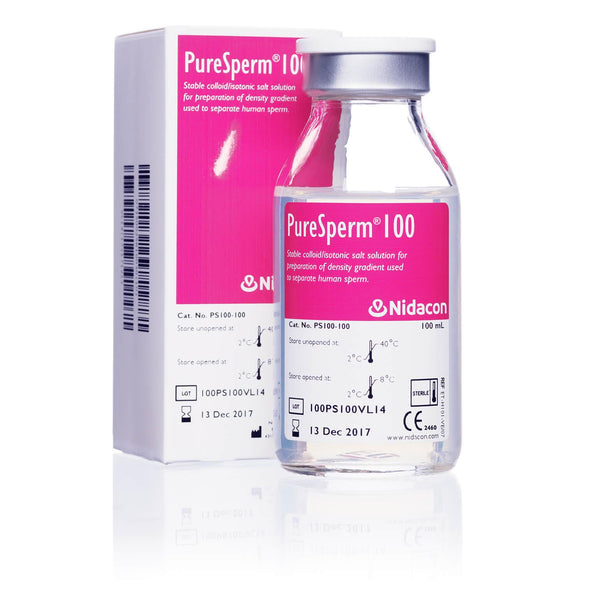PureSperm 100
For the preparation of density gradients
PureSperm 100 is a sterile colloidal silica suspension in an isotonic salt solution. It is optimized for the preparation of density gradients used to separate and purify human sperm from semen for use in Assisted Reproduction Technologies (ART). This system effectively separates normal sperm from lymphocytes, epithelial cells, abnormal, immature and senescent sperm, cell debris, bacteria and seminal fluid.
Features
- Increases sperm survival time.
- Removes sources of ROS.
- Removes bacteria.
- Removes sperm with abnormal DNA.
- Improves cryo-survival.
- Improves yield and recovery compared to swim-up techniques.
- 2 years shelf life.
- Pharmaceutical grade packaging to maintain product quality.
- Terminal sterilization by autoclaving.
- Cleared by regulatory authorities around the world.
- Produced according to cGMP and ISO standards.
PureSperm 100 stock suspension should be diluted with PureSperm Buffer to provide layers of different densities required for the gradient. For optimal results, the sperm pellet should be washed subsequently in PureSperm Wash. These three products together form an optimized system for the preparation of sperm for ART.
Components
- Silane-coated silica
- Calcium chloride
- Potassium chloride
- Sodium chloride
- Purified water
- HEPES
- EDTA
- Glucose
Performance Characteristics
- pH: 7.4-7.8.
- Osmolality (mOsm/kg H2O): 300-310.
- Endotoxin transfer during treatment : <1.0 EU/mL.
- Sperm survival 18 hours after density gradient separation: >70%.
Storage and Stability
- Store at 2 to 27ºC and avoid temperatures above or below these values. Under these conditions PureSperm 100 has a shelf-life of 24 months. The expiry date is shown on both bottles and cartons.
- Open and close bottles under aseptic conditions. After opening, store at 2 to 8ºC when not in use. Shelf-life on the product label applies when the product is stored according to manufacturer’s recommendations.
- No antibiotics, unstable additives or preservatives have been added by the manufacturer to PureSperm 100.
Precautions and warnings
- When retrieving the sperm pellet, follow the instructions given in the pack insert to avoid inadvertent contamination.
- Use aseptic procedures at all times.
- If available, use sealed buckets during centrifugation to avoid creation of aerosols.
- Clean accidental spills using a dampened cloth or paper. PureSperm 100 causes floors and benches to be extremely slippery.
- PureSperm 100 does not represent any kind of fire or combustion hazard. A material safety data sheet is available from the distributor or manufacturer.
- Do not use any solution which shows evidence of bacterial contamination.
- Do not use contents if tamper-evident seal is broken.
- Federal Law (USA) restricts this device to sale by or on the order of a physician.
- Please check for regulatory compliance governing the use of ART products in your country.
General Recommendations
Prepare two PureSperm gradients for each semen sample. This reduces the risk of overloading a single gradient, provides security when handling tubes or recovering sperm pellets, and provides two tubes to balance the centrifuge rotor.
Recommendations for Viscous Samples
It can be extremely difficult to obtain a high yield from motile sperm from highly viscous semen samples. Nidacon has developed a method that could be helpful to you in the lab. You simply add PureSperm Buffer to the ejaculate, incubate at 37°C for 15-30 minutes and the sample is ready to use. This will give you a much higher proportion of motile sperm.
Protocol:
For sperm preparation from a viscous semen sample:
1. Bring all solutions to room temperature.
2. Measure the volume of the semen sample.
3. Dilute 1+2 , 1 part PureSperm Buffer and 2 parts semen sample
(e.g. 0.5 ml PureSperm Buffer + 1.0 ml semen sample).
4. Incubate at 37°C for 15-30 minutes.
5. Mix using a pipette.
6. Ready for sperm preparation on a density gradient.
Documents
SDS – View PDF
Product insert (latest version) – View PDF
Leaflet – View PDF
Specifications:
| Mfr. No. PS100-100 | PureSperm 100 / 100 mL |
| Mfr. No. PS100-250 | PureSperm 100 / 250 mL |
| Mfr. No. PS100-1000K | PureSperm 100 / 4×250 mL |
References
Comparative proteomic analysis of spermatozoa isolated by swim-up or density gradient centrifugation
Stefania Luppi1, Monica Martinelli1, Elisa Giacomini2, Elena Giolo1, Gabriella Zito2, Rodolfo C Garcia3† and Giuseppe Ricci12*†
Reproductive Biology and Endocrinology 2015, 13:36
Comparison of the DNA Fragmentation and the Sperm Parameters after Processing by the Density Gradient and the Swim up Methods
Iraj Amiri, Marzieh Ghorbani, Safora Heshmati
Journal of Clinical and Diagnostic Research. 2012 November, Vol-6(9): 1451-1453
Comparative study of the effects of three semen preparation media on semen analysis, DNA damage and protamine deficiency, and the correlation between DNA integrity and sperm parameters.
Charoenchai Chiamchanya, Nattpawit Kaewnoonual, Pachara Visutakul, Sirikul Manochantr and Jirattikan Chaiya.
Asian J Androl. 2010 Mar;12:271-277.
The use of two density gradient centrifugation techniques and the swim-up method to separate spermatozoa with chromatin and nuclear DNA anomalies.
Sakkas D, Manicardi GC, Tomlinson M, Mandrioli M, Bizzaro D, Bianchi PG, Bianchi
U.Hum Reprod. 2000 May;15(5):1112-6.
DNA fragmentation of spermatozoa and assisted reproduction technology.
Henkel R, Kierspel E, Hajimohammad M, Stalf T, Hoogendijk C, Mehnert C, Menkveld R, Schill WB, Kruger TF.
Reprod Biomed Online. 2003 Oct-Nov;7(4):477-84.
Recovery and survival of sperm is higher with PureSperm density gradient than swim-up in neat and cryopreserved-thawed semen specimen.
P Ranganathan, A Agarwal
Fertil Steril, 2001
Comparative study on density gradients and swim-up preparation techniques utilizing neat and cryopreserved spermatozoa.
Allamaneni SS, Agarwal A, Rama S, Ranganathan P, Sharma RK.
Asian J Androl. 2005 Mar;7(1):86-92.
Bacterial contamination and sperm recovery after semen preparation by density gradient centrifugation using silane-coated silica particles at different g forces
C.M. Nicholson L. Abramsson, S.E. Holm and E. Bjurulf
Human Reproduction, Vol. 15, No. 3, 662-666, March 2000
The use of PureSperm, mini-Percoll and swim-up preparation techniques to separate spermatozoa with chromatin and nuclear DNA anomalies.
M. Tomlinson et al
Abstract Andrology in the nineties 1999
Higher rates of recovery with PureSperm density gradient compared to ISolate
Agarwal, A. and Ranganathan, P.ESHRE 2001
A comparison of two density gradient preparations for sperm separation for medically assisted conception: Effect on recovery, clean-up, motility, and motion parameter.
J. A. Roudebush, et al.
Supplement of the 27th Annual Meeting of American Society of Andrology, 81 Seattle, USA (March/April 2002)
Comparison of Six Density Gradient Media for Selection of Cryopreserved Donor Spermatozoa
Nathalie Mousset-Siméon, Nathalie Rives, Lydie Masse, Florence Chevallier and Bertrand Mace
Journal of Andrology, Vol. 25, No. 6, November/December 2004


